
Agonis flexuosa, commonly known as peppermint, is a species of flowering plant in the family Myrtaceae and is endemic to the southwest of Western Australia. The Noongar peoples know the tree as wanil, wonnow, wonong or wannang. It is a tree or shrub with pendulous, very narrowly elliptic, narrowly elliptic or narrowly egg-shaped leaves, white flowers with 20 to 25 stamens opposite the sepals and broadly top-shaped to broadly cup-shaped capsules.
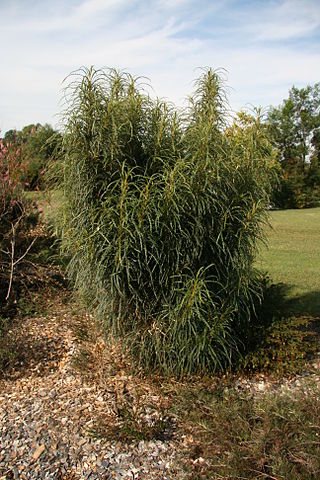
Banksia prolata is a species of bushy shrub that is endemic to Western Australia. It has linear, serrated or pinnatifid leaves, yellow flowers in heads of between 150 and 250, and egg-shaped follicles.
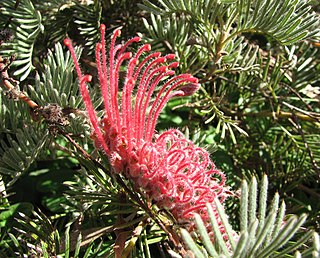
Grevillea thyrsoides is a species of flowering plant in the family Proteaceae, and is endemic to the southwest of Western Australia. It is a small, spreading or low-lying shrub, with pinnatisect to comb-like leaves, the end lobes linear, and clusters of hairy pinkish-red flowers.
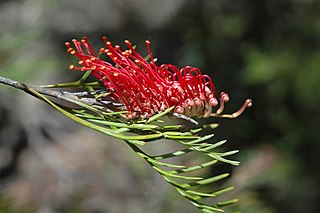
Grevillea hookeriana, commonly known as red toothbrushes or Hooker's grevillea, is a species of flowering plant in the family Proteaceae and is endemic to the south-west of Western Australia. It is a spreading to erect shrub, usually with linear leaves or deeply divided leaves with linear lobes, and toothbrush-shaped groups of red, black or yellowish green flowers, the style maroon to black.

Grevillea biformis is a species of flowering plant in the family Proteaceae and is endemic to the south-west of Western Australia. It is a shrub with linear leaves and cylindrical clusters of creamy white or pale pink flowers.

Grevillea refracta, commonly known as silver-leaf grevillea, is a species of plant in the protea family and is native to northern Australia. It is a tree or shrub usually with pinnatipartite leaves and red and yellow flowers arranged on a branched, downcurved raceme.

Grevillea obliquistigma is a species of flowering plant in the family Proteaceae and is endemic to the south-west of Western Australia. It is a spreading shrub with linear leaves, and conical to cylindrical clusters of creamy-white to yellowish cream-coloured flowers, sometimes tinged with pink.
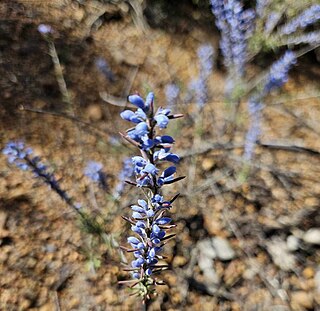
Conospermum amoenum, commonly known as blue smokebush, is a species of flowering plant in the family Proteaceae and is endemic to the south-west of Western Australia. It is an erect or spreading shrub with linear leaves, and spikes of blue or white tube-shaped flowers.

Conospermum canaliculatum is a species of flowering plant in the family Proteaceae, and is endemic to the south-west of Western Australia. It is a dense, multistemmed, erect shrub with linear leaves and spike-like panicles of woolly white, tube-shaped flowers.

Conospermum densiflorum, commonly known as crown smokebush, is a species of flowering plant in the family Proteaceae and is endemic to the south-west of Western Australia. It is an erect, much-branched shrub with thread-like leaves at the base of the plant, and spikes or corymbs of velvety, cream-coloured or blue, tube-shaped flowers.
Aggreflorum pallidum is a species of spreading shrub that is endemic to Queensland. It has thin, firm, rough bark, narrow lance-shaped leaves, white flowers arranged in groups of two or three on side shoots and fruit that remains on the plant until it dies.
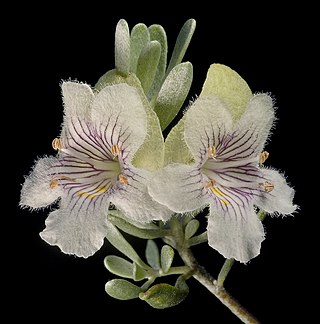
Prostanthera althoferi is a species of flowering plant in the family Lamiaceae and is endemic to inland areas of Australia. It is an erect shrub with its stems and leaves densely covered with silvery, greyish-green hairs, and has narrow egg-shaped leaves and white to cream-coloured flowers with mauve or purple striations inside.
Goodenia drummondii is a species of flowering plant in the family Goodeniaceae and is endemic to the south-west of Western Australia. It is an erect shrub with linear to lance-shaped stem leaves, and spike-like thyrses of small white flowers with purplish spots.

Goodenia scapigera, commonly known as white goodenia, is a species of flowering plant in the family Goodeniaceae and is endemic to the south-west of Western Australia. It is an erect, perennial herb or shrub with linear to narrow egg-shaped leaves clustered near the ends of the stems, and thyrses of white flowers with purplish spots.
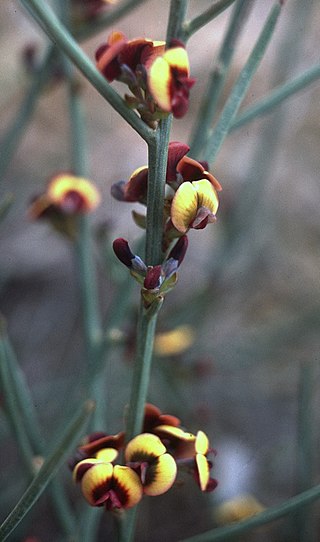
Daviesia debilior is a species of flowering plant in the family Fabaceae and is endemic to the south-west of Western Australia. It is a shrub with low-lying stems and many erect branchlets, scattered linear to scale-like phyllodes, and yellow, purplish, orange-pink and dark purplish flowers.

Daviesia decurrens, commonly known as prickly bitter-pea, is a species of flowering plant in the family Fabaceae and is endemic to the south-west of Western Australia. It is spreading, erect, or low-lying shrub with scattered, sharply-pointed, narrow triangular phyllodes, and yellowish pink and velvety red flowers.
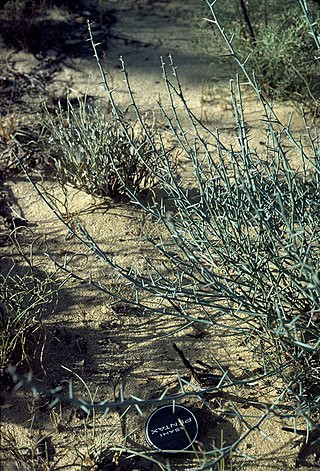
Daviesia sarissa is a species of flowering plant in the family Fabaceae and is endemic to inland areas of south-western Western Australia. It is a spreading or sprawling, glaucous shrub with scattered, long, rigid, cylindrical, sharply-pointed phyllodes, and orange-yellow and red flowers.
Spyridium mucronatum is a species of flowering plant in the family Rhamnaceae and is endemic to the south of Western Australia. It is an erect or spreading shrub usually with narrowly oblong leaves, and dense clusters of up to ten densely hairy, white to yellow flowers.

Pimelea lehmanniana is a species of flowering plant in the family Thymelaeaceae and is endemic to the southwest of Western Australia. It is a shrub with narrowly egg-shaped leaves and clusters of white to pale yellow flowers surrounded by 4 or 6, pale yellowish-green involucral bracts.

Conostylis seorsiflora is a rhizomatous, tufted perennial, grass-like plant or herb in the family Haemodoraceae and is endemic to the south of Western Australia. It has flat leaves and yellow, tubular flowers.


















